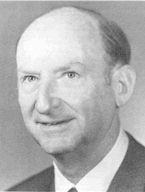Jan Rajchman
- Birthdate
- 1911/08/10
- Birthplace
- London, England, UK
- Death date
- 1989/04/01
- Associated organizations
- RCA (Radio Corporation of America)
- Fields of study
- Electron devices, Magnetic devices
- Awards
- Morris Liebmann Memorial Award, IEEE Edison Medal
Biography
Jan A. Rajchman was born on 10 August 1911, in London, where his father, a doctor, was engaged in medical research. At the age of seven he moved with his parents to their native Poland and three years later to Geneva, Switzerland. There he graduated from the College de Geneve in 1930. He obtained the Diploma of Electrical Engineering from the Swiss Federal Institute of Technology in Zurich in 1935 and a Doctor of Science in 1938.
Rajchman arrived in America as an immigrant in the spring of 1935, wanting to do research at RCA Laboratories which were pioneering in electronics, then a nascent technology. As the country was in the throes of a great depression and there were "no openings", he attended an MIT Summer Session. In August, RCA offered him a job in a Testing Department where variable condensers for radio receivers were calibrated against standards by bending the condenser plates by hand. He started working in January 1936 in an RCA Laboratory directed by Vladimir K. Zworykin. His association with Zworykin continued for many years.
Rajchman's first research was in electron multipliers. He developed an electronically focused type much simpler than magnetically focused types of the day. In a study that was the basis of his doctoral thesis he found ways to remove the main causes of dark current limiting the smallest light levels detectable by these phototubes.
Starting in 1939 Rajchman was among the first to consider the possibility of electronic computation and conceived many basic logic circuits, as well as an all "integrated" vacuum tube for arithmetic. He conceived a resistive matrix, the first true "read-only memory" which was widely used in early computers.
During World War II, Rajchman's analysis of the betatron in connection with possible applications of this electron accelerator to microwave devices, led to his being a co-recipient of the Levy Medal of the Franklin Institute in 1947. After the war, resuming work in computers, Rajchman was among the first to realize the importance of truly random high-speed digital memories. He conceived and developed the first once: the selectively addressable storage tube. Then, embarking into a new area, Rajchman conceived and developed many magnetic memories and switching devices. He independently conceived the core memory and made many contributions to it, notably means to cancel unwanted signals in sense windings. He invented the transfluxor, a multi-aperture core, which has unique analog and logic switching capabilities. He developed ferrite integrated memories. He received the 1960 Morris Liebmann Memorial Award from the IEEE for "his contributions to the development of magnetic devices for information processing."
Rajchman's contributions as an inventor were matched by his contributions as a research director and counselor to the many outstanding scientists who worked for and with him at RCA Laboratories. He was an Associate Director of Research in 1959, Director of the Computer Research Laboratory in 1961, and Vice President Data Processing in 1967. As a director of research he was responsible for a broad innovative program in data processing involving magnetic, superconductive, semiconductor and optical techniques to memory and logic, various input and output devices, computer theory, time sharing, and computer applications.
In 1973, Rajchman directed the development and demonstration by RCA Laboratories of the first holographic computer memory able to perform the full-cycle operation of write, store, read and erase. As Vice President of Information Sciences, Rajchman not only directed an exploratory research group at the David Sarnoff Research Center, RCA Laboratories, in Princeton, but was also responsible for the technical direction of research in RCA laboratories in Zurich and Tokyo. He retired in 1976.
Rajchman was a member of the National Academy of Engineering, a Fellow of the American Association for the Advancement of Science and the Franklin Institute. He held over 100 U.S. patents and was the author of many papers. He was awarded the 1974 IEEE Edison Medal "For a creative career in the development of electronic devices and for pioneering work in computer memory systems."
Rajchman was married to the former Ruth Teitrick, a graduate of Dickinson College who held a law degree from the Dickinson School of Law. While a member of the Philadelphia Bar, she became an attorney for the War Labor Board during World War II. They had two children, Alice R. Hammond and John A. Rajchman. Rajchman passed away on 1 April 1989.
Further Reading
Jan Rajchman and Albert S. Hoagland Oral History
“Dr. Jan Rajchman, 80, Electronics Engineer,” New York Times, Apr. 6, 1989.
